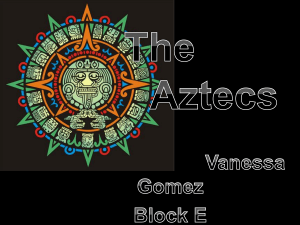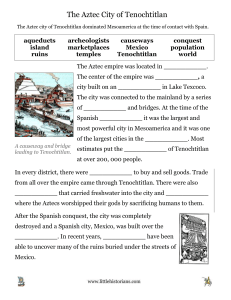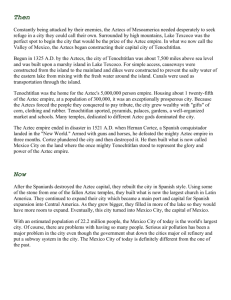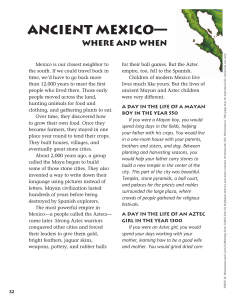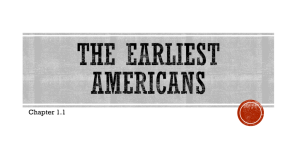UCL Institute of Archaeology ARCL G201 Monday 9-11 am Room B13
advertisement
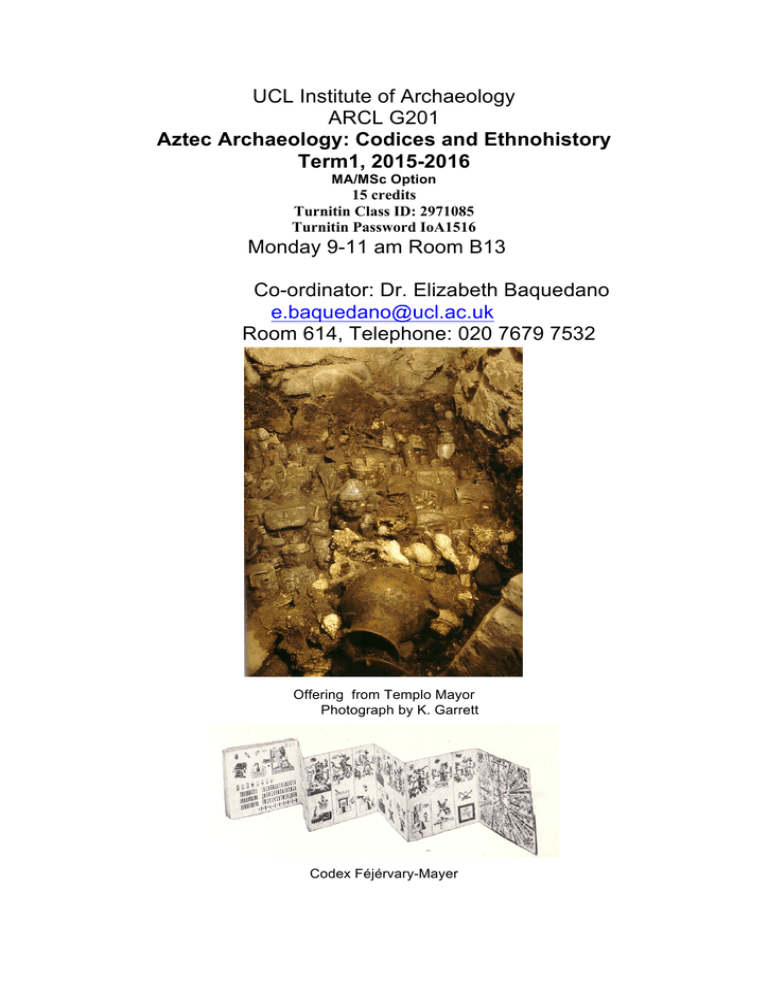
UCL Institute of Archaeology ARCL G201 Aztec Archaeology: Codices and Ethnohistory Term1, 2015-2016 MA/MSc Option 15 credits Turnitin Class ID: 2971085 Turnitin Password IoA1516 Monday 9-11 am Room B13 Co-ordinator: Dr. Elizabeth Baquedano e.baquedano@ucl.ac.uk Room 614, Telephone: 020 7679 7532 Offering from Templo Mayor Photograph by K. Garrett Codex Féjérvary-Mayer 2 OVERVIEW A brief summary of the course contents This course examines the critical boundaries between the historical records, the painted books (codices) and the material culture of archaeology. It focuses on the Spanish Chroniclers of Sixteenth Century Mexico who saw and recorded the dazzling brilliance of Aztec life and culture. The evidence from these two distinctive literary sources will be set against the insight gained by archaeological investigations over the last thirty years – in particular the excavations of the Great Temple of the Aztecs that has done so much to revolutionize our knowledge of that civilization. Moving back and forth between the indigenous painted books and the chronicles of Sixteenth century Mexico and archaeology, the student will be able to synthesize the information in order to understand Aztec culture, where religion, politics and economic concerns overlap in complex ways. The course begins with an overview of the Aztecs from their humble beginnings to Empire builders looking at the Aztec Annals and the archaeological evidence. We then turn to the Spanish Conquest examining the documentary evidence especially the writings of the Conquistadors Hernán Cortés and Bernal Díaz del Castillo as well as the writings of the Catholic friars Bernardino de Sahagún and Diego Durán. Summary of the method of delivery Aims of the module Classes will meet for two-hours a week. Responsibilities for leading discussion of the readings will be rotated among class participants. Students will select a topic of interest from the course content and write an assessed essay on this subject. 1) This course will provide students with different interpretive frameworks to develop their skills in critical evaluation of the archaeological, historical and ethno-historical sources resulting in a deeper understanding of Aztec civilization. Students will be able to learn new skills from the rare combination of three sources of knowledge to interpret the past. Intended learning outcomes 1) Critical analysis of the historical records 2) Have learned how to integrate ideas from a variety of sources. 3 3) A familiarity with case studies which illustrate current issues in Aztec archaeology using ethno-historical sources 4) Knowledge of Sixteenth century Aztec codices 5) Knowledge of codices produced in the Colonial period 4 Module Workload Distribution of learning hours WORK HOURS Lectures 10 Private reading 120 Seminars/ problem classes / tutorials 10 Laboratory / Studio Field work Independent project work Language work 48 Required written work (e.g. essays/reports) Revision E-learning/tutor led contact E-learning student led contact Other – please specify TOTAL 188 Assessment: 2 Essays (4000 Words), First essay 950-1050 words (25%) due on 23 November 2015, Second essay 2,850-3,150 words (75%)11 January 2016 Essay topics will be open, subject to agreement between the student and the Lecturer. The students will have agreed a topic by week four of the class. 2) For each session (3-10) submit a one-paragraph abstract from one of the readings, to be submitted at each session. TEACHING METHODS The course is taught through lectures and seminars. Responsibilities for leading discussion of the readings will be rotated among class participants. Students will be expected to have read the weekly -recommended readings, and to actively contribute to discussion. 5 LIBRARIES AND OTHER RESOURCES In addition to the Library of the Institute of Archaeology, other libraries in UCL with holdings of particular relevance to this degree are: The UCL Science Library (Anthropology, sections). There may also be relevant sources in the Centre for Anthropology at the British Museum. Senate House has a good collection of codices. Turnitin advisors will be available to help you at specified times if you need help generating or interpreting the reports. Turnitin advisors: ioa-turnitin@ucl.ac.uk Course Code 2971086 Password IoA1516 Course Schedule Outline 2015 Term I. Monday. 9-11 am Room B13 Week 1. 5 Oct. Introduction Week 2. 12. Oct. Tenochtitlan: The Rise of Aztec Civilization Week 3. 19 Oct. The Triple Alliance, Nezahualcoyotl King of Texcoco, intellectual, architect and builder. Week 4. 26 Oct.. The Great Temple of the Aztecs: The sacred precinct of Tenochtitlan Week 5. 2 Nov. Case study: The recent find of Ahuitzotl’s Tomb, Eighth Aztec ruler READING WEEK (NO TEACHING) 9 Nov-13 Nov Week 6. 16 Nov. The Commercial Economy: The Tlatelolco Market Week 7. 23 Nov. Codex Mendoza and Tribute Week 8. 30 Nov. The New Fire Ceremony: The Hill of the Star: Citlaltepec Week 9. 7 Dec. Case study: Recent discoveries at Zultepec, Cortés and the Spanish Contingent Week 10. 14. Dec. The Conquest of Mexico 2. Tenochtilan: The Rise of Aztec Civilization WEEK 2: OCT 12 TENOCHTITLAN: THE RISE OF AZTEC CIVILIZATION In this session we will first look at the native histories to understand the early Aztec history and the nature of the interaction among city-states. We will aim to discuss War, Trade and Marriage Alliances during the Early Aztec Period. 6 Codex Azcatitlan Readings: Barlow, Robert H., and Michel Graulich, eds. 1995 Codex Azcatitlan, 2 vols. Facsimile, with commentary by Barlow revised by Graulich. Spanish translation by Leonardo López Luján, French translation by Dominique Michelet. Paris: Bibliothèque Nationale de France and Société des Américanistes. Boone Hill, Elizabeth 1991Migration Histories as Ritual Performance. In: Carrasco, D. ed. To Change Place: Aztec Ceremonial Landscapes. pp.121-151 Niwot: University Press of Colorado. Códice Boturini o Tira de la Peregrinación. In Antiguedades de México basadas en la recoplilación de Lord Kingsborough 2:8-29. Commentary by José Corona Nuñez. SHCP, Mexico Cortés, Hernán 1986 Letters from Mexico. Translated an edited by Anthony Pagden. New Haven: Yale University Press. Second Letter. Teaching Collection INST ARCH 3590 Mundy, Barbara E. 2015 The Death of Aztec Tenochtitlan, The Life of Mexico City Austin: University of Texas Press Read Chapter 1 Sahagún, Fray Bernardino de 1950-82. Florentine Codex: General History of the Things of New Spain. 12 books. Edited and translated by Arthur J.O. Anderson and Charles E. Dibble. The School of American Research, Santa Fe, and the University of Utah, Salt Lake City, Book 12. 7 Smith, Michael 2012 The Aztecs Oxford: Blackwell Publishing. Read Chapter two 3. The Triple Alliance. Nezahualcoyotl King of Texcoco: intellectual, architect and builder WEEK 3: Oct 19 In this session we will see the formation of The Triple Alliance (Tenochtitlan, Texcoco and Tlacopan), this alliance was decisive in forging the Aztec Empire. These polities formed a strong military-economic unity. We will review how the Aztecs (Mexica) rose to power and transformed from a tribe into an Empire. Readings (select two as required reading) Nezahualcoyotl, Alva Ixtlilxóchitl, Fernando de CodeIIxtIxtlilxochitl 1985.Obras Históricas. 2 vols. Ed. Edmundo O'Gorman. UNAM, IIH, Mexico Lee, Jongsoo. 2008. The Allure of Nezahualcoyotl: Pre-Hispanic History, Religion, and Nahua Poetics. Albuquerque: University of New Mexico Press. Read chapter four ‘Re-examining Nezahualcoyotl’s Texcoco: Politics, Government and Legal System’, pp. 96-130. Lee, Jongsoo, 2014. The Aztec Triple Alliance: A Colonial Transformation of the Prehispanic Political and Tributary System. In Texcoco: Prehispanic and Colonial Perspectives. Ed. By Jongsoo Lee and Galen Brokaw Boulder: University Press of Colorado. Quiñones Keber, Eloise (ed.) 1995. Codex Telleriano-Remensis. Austin: University of Texas Press Barlow, Robert H., and Michel Graulich (editors) 1995 Codex Azcatitlan. Paris: Bibliothèque Nationale de France.Société des Américanistes. Dibble, Charles E. 1980 Codex Xolotl. Instituto de Investigaciones Históricas, UNAM: Mexico Parsons, Jeffrey An Archeological Evalution of the Códice Xolotl. In American Antiquity, vol. 35, 1970, pp. 431- 440 8 Prehistoric settlement patterns in the Texcoco region, Mexico, University of Michigan, Memoirs of the Museum of Anthropology, no.3, Ann Arbour 1971 Mohar Betancourt, Luz María 2004 Códice Mapa Quinatzin: Justicia y derechos humanos en el México antiguo México: Miguel Angel Porrúa Pomar, Juan Bautista 1975 Relación de Tezcoco. Joaquín García Icazbalceta (ed.) Biblioteca Enciclopédica del Estado de México, Mexico 4. The Great Temple of the Aztecs: the sacred precinct of Tenochtitlan WEEK 4: Oct 26 This session studies the most important religious and economic center of the Aztecs. The Great Temple with its twin temples dedicated to Huitzilopochtli, tribal god of the Aztecs and Tlaloc, god of rain. The Great Temple has been thoroughly excavated revealing over 150 offerings that are closely linked to either warfare or agriculture. We will approach the subject reading both the ethnohistorical sources as well as the finds from archaeology. Readings: López Luján, Leonardo 2005 The Offerings of the Templo Mayor of Tenochtitlan. Revised ed. translated by Bernard R. Ortiz de Montellano and Thelma Ortiz de Montellano. Albuquerque: University of New Mexico Press. López Austin, Alfredo and Leonardo López Luján El sacrificio humano entre los mexicas http//www.mesoweb.com/aboutarticles/AM103pdf Matos Moctezuma, Eduardo (compiler) 1981 El Templo Mayor de Mexico: Crónicas del siglo XVI Asociación Nacional de Libreros, A.C., México Matos Moctezuma, Eduardo 1988 The Great Temple of the Aztecs: Treasures of Tenochtitlan. London: Thames and Hudson 9 Sahagún, Bernardino de 1983 Primeros Memoriales: Facsimile Edition. Photographed by Ferdinand Anders. Norman: University of Oklahoma Press. Umberger, Emily 2014 Tezcatlipoca and Huitzilopochtli: Political Dimensions of Aztec Deities. In Tezcatlipoca: Trickster and Supreme Deity, ed. Elizabeth Baquedano, Boulder: University Press of Colorado, pp. 83-112 WEEK 5: Nov 16 The systematic excavations of the Great Temple of the Aztecs have provided us with detailed information on many aspects of Aztec life, particularly Aztec ritual. Recently the tomb of the Aztec ruler Ahuitzotl was uncovered. This session will aim at comparing and contrasting the information provided by the Chroniclers of Sixteenth century Mexico as well as the information gathered during the excavation which is on-going. Readings: Alvarado Tezozomoc, Fernando de 1975 Crónica Mexicana.(ed.), Manuel Orozco y Berra. México: Porrúa. Baquedano, Elizabeth 2011 ‘Concepts of Death and the Afterlife in Central Mexico’, Fitzsimmons, J.L. and Shimada, I. (eds.), Living with the Dead Mortuary Ritual in Mesoamerica, Tucson: University of Arizona Press, pp.203-230. Tlaltecuhtli Templo Mayor Durán, Fray Diego 1994 The History of the Indies of New Spain. Translated and edited by Doris Heyden. Norman: University of Oklahoma Press. Read Chapters 50-51 Durán, Diego 1984 Historia de las Indias de Nueva España e Islas de la Tierra Firme, Angel M. Garibay (ed.) Porrúa: Mexico López Luján, Leonardo and Chávez Balderas, Ximena, 2009. In search of Mexica kings: current excavations in Tenochtitlan. In Moctezuma Aztec Ruler Colin McEwan and Leonardo López Luján, Eds. pp. 294-297. London: The British Museum Press López Luján, Leonardo 2010 Tlaltecuhtli 10 México: CONACULTA/INAH Peñafiel, Antonio 1902 Códice Aubin., Manuscrito Azteca de la Biblioteca Real de Berlin. Reprinted in 1980 by Editorial Innovación, México. Quiñones Keber, Eloise (Ed.) 1995 Codex Telleriano-Remensis Austin: University of Texas Press. Sanders, William T 2006 The Templo Mayor: History and Archaeology In Arqueología e historia del Centro de México.L. López Luján, D. Carrasco, L. Cué, (eds.) Mexico: Instituto Nacional de Antropología e Historia, pp. 291-304 6 The Commercial Economy: The Tlatelolco Market WEEK 6: Nov 23 Tlatelolco was the twin city of Tenochtitlan that became the major commercial city of central Mexico in the fifteenth century. Its market grew into the largest and wealthiest of the Basin of Mexico. In this seminar we will study the descriptions of Bernal Díaz del Castillo and the archaeological excavations - past and present- of the ceremonial precinct. Readings: Díaz del Castillo, Bernal 1927 The True History of the Conquest of Mexico. 2 vols. Translated by Maurice Keatinge. New York: Robert M. McBride & Company Durán, Diego 1971 Book of the Gods and Rites and The Ancient Calendar Translated and edited by Fernando Horcasitas and Doris Heyden. Norman: University of Oklahoma Press. Read Chapter XX. Solís, Felipe and David Morales El Período Indígena de Tlatelolco: Arqueología e Historia. In Tlatelolco Mexico: Secretaria de Relaciones Exteriores 1990, pp.13-36 11 Guilliem Arroyo, Salvador 1999 Ofrendas a Ehecatl-Quetzalcoatl en México-Tlatelolco: Proyecto Tlatelolco, 1987-1996. Serie Arqueología, Instituto Nacional de Antropología e Historia. Guilliem Arroyo, Salvador 199 Discovery of a Painted Mural at Tlatelolco. In: Carrasco, D. ed. To Change Place: Aztec Ceremonial Landscapes. Niwot, University Press of Colorado, pp. 2023. Teaching Collection INST ARCH 3591 Guilliem Arroyo, Salvador La caja de agua del Imperial Colegio de la Santa Cruz de Tlatelolco. In Estudios de Cultura Nahuatl, México: UNAM, Vol. 38, 2007, pp.15-32 Guilliem Arroyo, Salvador. Los contextos sacrificiales de Mexico-Tlatelolco. In El sacrificio humano en la tradición religiosa mesoamericana eds. L. López Luján and G. Olivier, 2010, pp. 275-300. Mexico: INAH/UNAM 7. Codex Mendoza and Tribute WEEK 7: Nov. 30 The richest information of Mesoamerican tribute comes from the Aztec empire. The second part of Codex Mendoza deals with tribute listing the provinces, the tribute goods and the quantities to be paid to Tenochtitlan. In this session we will look at the wide range of commodities delivered from conquered provinces both in Codex Mendoza and in the archaeological record. We will pay special attention to Gold and Metals. Readings: Baquedano, Elizabeth 2014 Tezcatlipoca as a Warrior: Wealth and Bells. In Tezcatlipoca: Trickster and Supreme Deity. Boulder: University Press of Colorado, pp. 113-133 Berdan, Frances F., and Patricia Rieff Anawalt (Eds.) 1992 The Codex Mendoza. 4 vols. Berkeley: University of California Press Matos Moctezuma, Eduardo 1988. The Great Temple of the Aztecs: Treasures of Tenochtitlan. London: Thames and Hudson 12 López Luján, Leonardo 2005. The Offerings of the Templo Mayor of Tenochtitlan. Revised edition Translated by Bernard R. Ortiz de Montellano and Thelma Ortiz de Montellano. Albuquerque: University of New Mexico Press. López Luján, Leonardo y José Luis Ruvalcaba Sil, “El oro de Tenochtitlan: la colección arqueológica del Proyecto Templo Mayor”, Estudios de Cultura Náhuatl, México, Instituto de Investigaciones Históricas, UNAM, v. 49, 2015, pp. 7-57. 8. The New Fire Ceremony. The Hill of the Star: Citlaltepec WEEK 8: Dec. 14 This session aims to understand the importance of ritual life in Aztec Mexico. At the end of the cycle of 52 years, the New Fire Ceremony took place to celebrate the renewal of time once the sun began to rise on the first day of a new calendar round. This event took place at the Hill of the Star (Citlaltepec). We will use the Codex Borbonicus to explain the importance of this ceremony and the archaeological finds from the New Fire ceremony. Codex Borbonicus Readings: Codex Borbonicus 1974 Bibliothèque de l’Assemblée Nationale Française, commentary by Karl Anton Nowotny. Akademische Druck-und Verlagsanstalt, Graz Couch, Christopher Images of the Common Man in the Codex Borbonicus. In Estudios de Cultura Nahuatl. Mexico: UNAM, vol. 17, 1984, pp. 89-100. Elson, Christina M., and Michael Smith Archaeological Deposits from the New Fire ceremony. Ancient Mesoamerica 2001,12: 157-174 Quiñones Keber, Eloise (ed.) 1995 Codex Telleriano Remensis. Austin: University of Texas Press Sahagún, Bernardino de 1950-78 Florentine Codex: General History of the Things of New Spain. Translated by Arthur J. O. Anderson and Charles Dibble 12 books, Santa Fe. Book 7 13 9. Case study: Recent discoveries at Zultepec, Cortés and the Spanish Contingent. WEEK 9: Dec 7 The excavations at Zultepec (Tlaxcala) have provided us with a new insight into the Conquest of Mexico. During the excavations several skeletal remains were found, among them, fourteen skulls of Spaniards. The skulls have perforations at the parietals suggesting that they were placed in skull racks. In this session we will read the writings of Cortés comparing and contrasting them with the archaeological finds. The variety of artifacts both European and Aztec throw new light on the Conquest Period. Skulls found at Zultepec (photograph Arqueología Mexicana) Readings: Códice Chimalpopoca: Anales de Cuauhtitlan y Leyenda de los Soles.1975 [1945]. 2nd ed. Translated and edited by Primo Feliciano Velázquez. UNAM: Mexico Martínez Vargas, Enrique Zultépec-Tecoaque: Sacrificios de Españoles u sus Aliados Durante la Conquista. In Arqueología Mexicana Vol. XI – num. 63, pp. 52-57 Sept – Oct 2003 Cortés, Hernán 1986 Letters from Mexico, translated and edited by Anthony Pagden. New Haven: Yale University Press. Third Letter Díaz del Castillo, Bernal 1956 The Discovery and Conquest of Mexico. Translated by A. P. Maudslay. Farrar, Straus, and Cudahy: New York 10. The Conquest of Mexico WEEK 10:Dec.14 This session will make use of the documents of both Mexican and European witnesses of the Conquest. The Lienzo de Tlaxcala is an important book that describes the Conquest as the Tlaxcaltecas lived it. On the other hand, we have 14 several Spanish accounts of the Conquest. This session will aim to use the accounts of both Mexicans and Spaniards followed by a discussion by class participants. Readings: Barlow, Robert H., and Michel Graulich, Eds. 1995 Codex Azcatitlan, 2 vols. Facsimile, with commentary by Barlow revised by Michel Graulich. Spanish translation by Leonardo López Luján, French translation by Dominique Michelet Paris: Bibliothèque Nationale de France and Société des Américanistes. Cortés, Hernán 1986 Letters from Mexico. Translated and edited by Anthony Pagden. Yale University Press, New Haven Díaz del Castillo, Bernal 1956 The Discovery and Conquest of Mexico. Translated by A. P. Maudslay. Farrar, Straus, and Cudahy, New York De la Torre, Mario (Ed) 1983 Lienzo de Tlaxcala. Mexico: Cartón y Papel de México, S.A. de C.V. Elliot, John H The overthrow of Moctezuma and his empire. In Moctezuma Aztec Ruler, ed. by Colin McEwan and Leonardo López Luján, 2009, pp. 218-237. Maffie, James 2014 Aztec Philosophy: Understanding a World in Motion Boulder: University Press of Colorado Magaloni, Diana 2007 Painting a New Era: Conquest, Prophecy and the World to Come. In Invasion and Transformation ed. by P. Brienen and M. Jackson, Boulder: University Press of Colorado pp. 125-152, Sahagún, Bernardino de 1950-78 Florentine Codex: General History of the Things of New Spain. Translated by Arthur J. O. Anderson and Charles Dibble, 12 books, Santa Fe, Book 12 Tezozomoc, Hernando Alvarado 1944 Crónica Mexicana. Reprinted by Editorial Leyenda, Mexico Townsend, Camilla 2006 Malintzin’s Choices: An Indian Woman in the Conquest of Mexico Albuquerque: University of New Mexico Press Additional Readings Aimi, Antonio 2009 La Verdadera Visión de los Vencidos: La conquista de México en las fuentes aztecas Alicante: Publicaciones de la Universidad de Alicante 15 Boxt, Matthew and Brian Dervin Dillon (Eds.) 2012 Fanning the Sacred Flame Boulder: University Press of Colorado Boone, Elizabeth 2007 Cycles of Time and Meaning in the Mexican Books of Fate Austin: University of Texas Press Brotherston, Gordon 1995 Painted Books from Mexico London: Trustees of the British Museum 2005 Feather Crown: The Eighteen Feasts of the Mexica Year London: The Trustees of the British Museum Dodds Pennock, Caroline 2008 Bonds of Blood Basingstoke: Palgrave Macmillan Klor de Alva, J. Nicholson, H. B. and Quiñones Keber, Eloise (Eds.) 1988, The Work of Bernardino de Sahagún, Pioneer: Ethnographer of SixteenthCentury Aztec Mexico. Institute for Mesoamerican Studies, The State University of New York, Albany. University of Texas Press, pp. 53-62. León- Portilla, M 1966 The Broken Spears: The Aztec Account of the Conquest of Mexico. Boston: Beacon Press. Magaloni, Diana Imágenes de la conquista de México en los códices del siglo XVI. Una lectura de su contenido simbólico. In Anales del Instituto de Investigaciones Estéticas, UNAM: vol. 82: 2003, pp. 5-45. Matos Moctezuma, Eduardo and Leonardo López Luján 2009 Escultura Monumental Mexica Mexico: Fundación Conmemoraciones Olko, Justyna 2005 Turquoise Diadems and Staffs of Office: Elite Costume and Insignia of Power in Aztec and Early Colonial Mexico Polish Society for Latin American Studies and Centre for Studies on the Classical Tradition, University of Warsaw Thomas, Hugh 1993 The Conquest of Mexico. London: Hutchinson Villela, K and Mary Ellen Miller 2010 The Aztec Calendar Stone Los Angeles: The Getty Research Institute Wake, Eleanor 16 Codex Tlaxcala: New Insights and New Questions. In Estudios de Cultura Nahuatl, Mexico: UNAM, vol. 33, 2002, pp.91-140 Web sites www.mesoweb.com www.famsi.org APPENDIX INSTITUTE OF ARCHAELOGY COURSEWORK PROCEDURES General policies and procedures concerning courses and coursework, including submission procedures, assessment criteria, and general resources, are available in your Degree Handbook and on the following website: http://wiki.ucl.ac.uk/display/archadmin. It is essential that you read and comply with these. Note that some of the policies and procedures will be different depending on your status (e.g. undergraduate, postgraduate taught, affiliate, graduate diploma, intercollegiate, interdepartmental). If in doubt, please consult your course coordinator. GRANTING OF EXTENSIONS: New UCL-wide regulations with regard to the granting of extensions for coursework have been introduced with effect from the 2015-16 session. Full details will be circulated to all students and will be made available on the IoA intranet. Note that Course Coordinators are no longer permitted to grant extensions. All requests for extensions must be submitted on a new UCL form, together with supporting documentation, via Judy Medrington’s office and will then be referred on for consideration. Please be aware that the grounds that are now acceptable are limited. Those with long-term difficulties should contact UCL Student Disability Services to make special arrangements. 17


